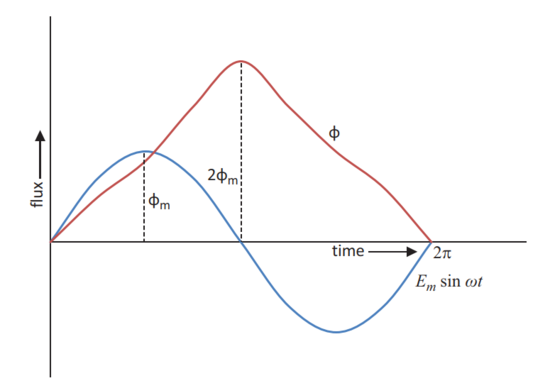Power:Transformer Inrush Current: Difference between revisions
| Line 6: | Line 6: | ||
If the switching on is at the instant of voltage zero, the flux is initiated from the same origin of the voltage. The flux is the integral of the voltage, and the value of flux at time π can be written as | If the switching on is at the instant of voltage zero, the flux is initiated from the same origin of the voltage. The flux is the integral of the voltage, and the value of flux at time π can be written as | ||
: <math> {\phi} = {\phi}_m \int_{0}^{\pi}\sin wt | : <math> {\phi} = {\phi}_m \int_{0}^{\pi}\sin{wt} \text{ d}wt \, </math> | ||
: <math> {\phi} = 2{\phi}_m \, </math> | |||
The excessive demand of flux would saturate the core and result in a sharp increase of the magne- tizing current. This increased current is termed as inrush current, and its magnitude can become several times of the full load current. | |||
When the transformer is switched off, magnetizing current will follow a hysteresis loop and some residual flux may be retained in the core. If the residual flux, <math>\phi r</math>, is in the direction of the flux build-up, the peak flux would become <math>2\phi m + \phi r</math>, resulting in much higher inrush current. The waveform of the inrush current is a half-cycle sinusoidal wave superimposed by a DC component. | |||
Revision as of 04:26, 21 September 2023
Transformer Inrush Current
When a transformer works normally, the flux produced in the core is orthogonal to the applied voltage. When the voltage is zero, the flux waveform is at its negative peak. When a transformer is switched on from the primary by keeping the secondary open circulated, it acts as a simple induc- tance and the flux will start from zero as shown in Figure 1.
If the switching on is at the instant of voltage zero, the flux is initiated from the same origin of the voltage. The flux is the integral of the voltage, and the value of flux at time π can be written as
The excessive demand of flux would saturate the core and result in a sharp increase of the magne- tizing current. This increased current is termed as inrush current, and its magnitude can become several times of the full load current.
When the transformer is switched off, magnetizing current will follow a hysteresis loop and some residual flux may be retained in the core. If the residual flux, , is in the direction of the flux build-up, the peak flux would become , resulting in much higher inrush current. The waveform of the inrush current is a half-cycle sinusoidal wave superimposed by a DC component.




